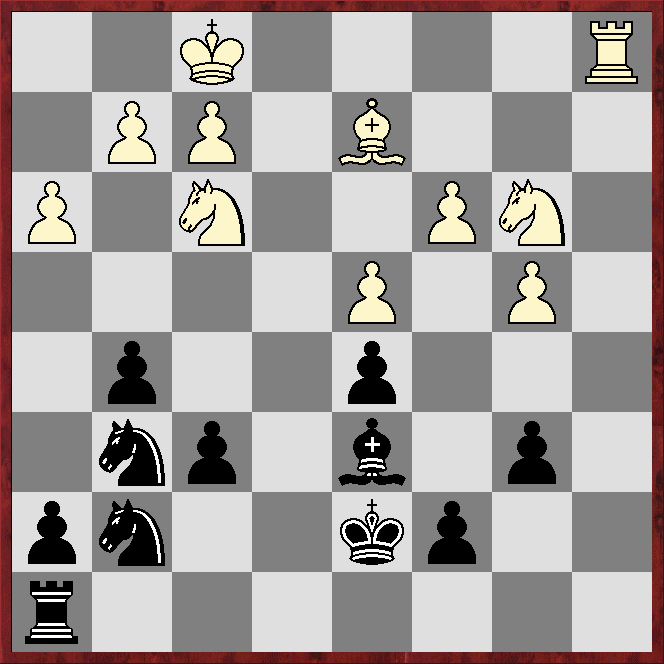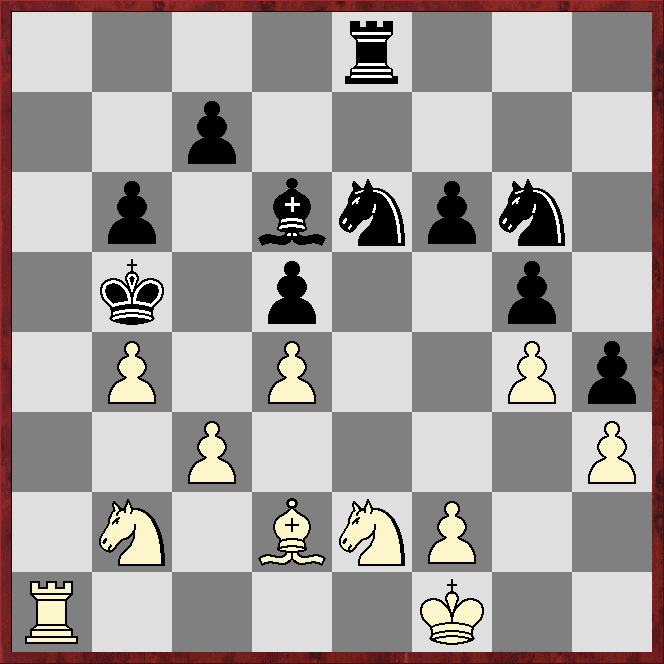Spanton (2013) - Bob Holliman (1930)
French Exchange
1.e4 e6 2.d4 d5 3.exd5 exd5 4.Nf3 Nc6!?
Commoner moves are 4...Bg4, 4...Nf6 and especially 4...Bd6.
5.c3
The mainline in ChessBase's 2024 Mega database runs 5.Bb5!? Bd6 6.c4!? dxc4!? 7.d5!? a6 8.Ba4!? b5 9.dxc6 bxa4 10.0-0 Ne7 11.Qxa4 0-0, all of which first occurred, at least in Mega24, in Garry Kasparov (2770) - Evgeny Bareev (2680), Paris Immopar Rapid 1991. Stockfish17 and Dragon1 reckon the resulting position is equal, although Kasparov went on to win.
5...Bd6 6.Bd3 Nge7 7.0-0 Bg4 8.Re1 Qd7 9.Nbd2 0-0-0!?
Castling queenside is often touted as a good way for Black to avoid the perceived drawish nature of 3.exd5, although here the move is strongly disliked by the engines. Nevertheless the text has been played by Alekhine, Spielmann, Psakhis, Szabo and Short, who may be better judges of such imbalanced setups.
*****
*****
*****
*****
Black is ahead on development, but White is well-placed to commence queenside operations - better placed, it would seem, than Black on the kingside. The engines reckon White has the upper hand.
10.b4 f6!?
This has been played by Caruana. The engines prefer the most popular move, 10...Ng6, although Psakhis and Short chose 10...Rde8.
11.a4!?
The engines like 11.Qa4.
11..g5?!
Twelve of 17 games in Mega24 saw the text, but the engines reckon it is too slow.
12.a5
Almost certainly not 12.b5?! Na5.
12...Bf5
*****
*****
*****
*****
13.Nb3
The engines' 13.Bf1!, which would apparently have been a novelty, never crossed my mind, but it makes perfect sense. From f1 the light-square bishop continues to have an influence on the queenside, and strengthens White's kingside defences. True, Black's light-square bishop controls b1, but it also impedes some of Black's kingside options.
13...Bxd3 14.Qxd3 Qf5 15.Qxf5
Again the engines want White to avoid exchanges, probably by 15.Qf1!?
15...Nxf5 16.Re6 Rdf8
White is on top after 16...g4?! 17.Rxf6 gxf3 18.Rxf5 fxg2 19.Bh6, according to the engines.
17.Bd2 Ng7 18.Re2 Re8 19.Rae1 Rxe2 20.Rxe2 b6 21.h3 Kd7 22.Kf1 Ne7 23.Re1 Ng6 24.axb6 axb6 25.Ra1
 |
| 25.Ra1 stops the black rook from using the open a file, but White's rook is unlikely to find any joy there |
*****
*****
*****
*****
25...h5 26.Ng1!? Nf5 27.g3 h4 28.g4 Ng7 29.Ne2 Ne6 30.Nbc1 Kc6!? 31.Nd3 Kb5 32.Nb2 Re8
If Black had seen what was coming, he should have preferred 32...Nef4, when the engines give best-play as 33.Nxf4 Nxf4 (33...Bxf4 34.Be3) 34.Bxf4 Bxf4, awarding Black at least the better side of equality.
*****
*****
*****
*****
33.c4+! dxc4
More-or-less forced as 33...Kc6?! loses material to 34.cxd5+ Kxd5 35.Nxc3+! Kxd4 36.Rd1, when the threat is mate-in-three starting with 37.Be1+. Black can stave this off with 36...Nef8! (36...Bxb4 37.Ne2+ Kc5 38.Nd3+ and 39.Nxb4), but 37.Nb5+ Kd5 38.Bxg5+ Kc6 39.Nxd6 cxd6 40.Bxf6 leaves White a sound pawn up.
34.d5?
White is lost after this, whereas 34.Nc3+! Kxb4 35.Rb1 is strong, eg 35...b5 36.d5 Nef4?! (the engines' 36...Ka5!? is probably better, but simply answered by 37.dxe6) 37.Nd3+ Ka5 38.Nxb5+ Bb4 39.Nxf4 Bxd2 40.Nxg6, or 35...Ka5 36.Nxc4+ Ka6 37.Nb5 Bf4 38.Bxf4 Ngxf4 39.Nbd6! cxd6 40.Nxd6, when, thanks to the threat of 41.Ra1#, White wins the black rook. These are sharp lines, but in any event 34.Nc3+! is much better than the text.
34...Be5!
Not 34...Nef4?? 35.Nd4#.
35.dxe6
There is nothing better, but Black is roughly equivalent of more than a rook ahead, according to the engines.
35...Bxb2 36.Rb1 Be5 37.Bc3 Rxe6 38.Bxe5 Rxe5 39.Nd4+ Ka6 40.Nc6 Rd5 41.b5+ Kb7
Not so clear is 41...Rxb5?! 42.Nb8+.
42.Rb4 Nf4 43.Ke1? Nd3+ 0-1



Yes 34.d5 is bad,after Nc3 you got a good game at least you don,t have to loose it.a little bit pitty for the tournament,but there are more to come.
ReplyDeleteIt was a double-pity - the game decided the outcome of the 200-euro seniors' prize!
ReplyDeleteIt is Indeed!
Delete